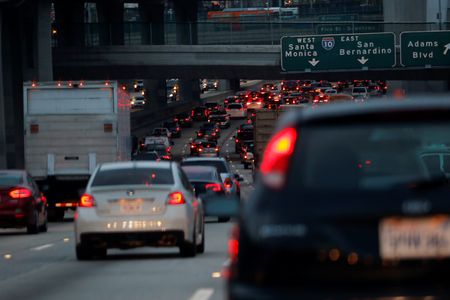
By David Shepardson
WASHINGTON (Reuters) -The U.S. Environmental Protection Agency (EPA) on Monday said it was proposing new rules to cut smog-forming and greenhouse gas emissions from heavy duty vehicles.
The EPA is proposing to require cuts in nitrogen oxide emissions from heavy trucks that would result in a drop of 47% to 61% by 2045, the first proposed cuts to NOx for heavy duty trucks since 2001. The new standards would begin in the 2027 model year.
The administration also proposes https://www.epa.gov/system/files/documents/2022-03/hd2027stds-nprm-2022-03.pdf stricter new greenhouse gas emissions standards for some types of heavy vehicles.
“These new standards will drastically cut dangerous pollution by harnessing recent advancements in vehicle technologies from across the trucking industry as it advances toward a zero-emissions transportation future,” EPA Administrator Michael Regan said.
The Truck and Engine Manufacturers Association said it would work “with EPA to ensure that the final version of today’s rule is practical, technically feasible, cost-effective, and will result in the necessary fleet turnover to achieve the nation’s environmental objectives.”
The group noted engines made after 2010 emit roughly 30 times less NOx than those made before 2010, but only about 50% of the fleet has turned over.
The EPA also proposes lengthening emission warranty periods.
The EPA said the rules would dramatically improve air quality could reduce up to 2,100 fewer premature deaths and 3.1 million fewer cases of asthma symptoms and other health issues.
EPA separately plans to set new greenhouse gas emissions standards for heavy-duty vehicles as soon as 2030.
The EPA estimates the program will cost manufacturers $19 billion to $31 billion through 2045 but will have net benefits of up to $220 billion.
EPA said the rules could result in up to 2% increase in Class 8 trucks in the months before the 2031 standards begin and a commensurate decrease in sales in the year after they take effect.
Separately, the Transportation Department announced $1.5 billion in funding to help state and local governments purchase electric transit buses and low-emission models and $2.2 billion in funding to 35 transit agencies in 18 states.
(Reporting by David ShepardsonEditing by Chizu Nomiyama and Marguerita Choy)

